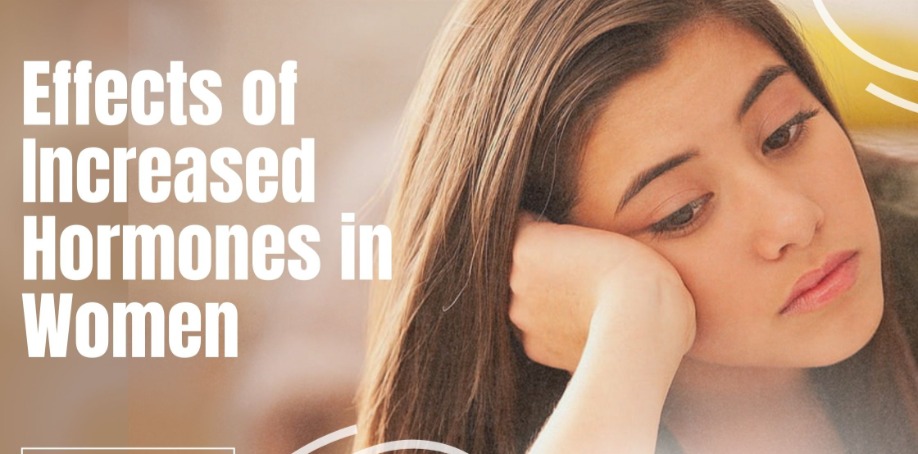Effects of Increased Hormones in Women
Hormones play a vital role in regulating various bodily functions, and any imbalance can lead to significant health issues. In women, an increase in hormones can result from a variety of factors, and this can have diverse effects on their physical and emotional well-being. In this article, we will explore the potential consequences of increased hormones in women, as well as how these imbalances occur, when hormones peak, and how to recognize the signs of hormonal imbalance.

Dr Disha Sridhar
I am a Gynaecologist Obstetrician ( MD, DNB OBGYN) with an emphasis on INTEGRATIVE MEDICINE.

Hormonal Changes in Women:
Hormonal fluctuations are a natural part of a woman's life, occurring during puberty, the menstrual cycle, pregnancy, and menopause. However, when hormonal levels rise beyond what is considered normal, it can lead to various complications.
Polycystic Ovary Syndrome (PCOS): Increased androgen hormones, such as testosterone, can lead to PCOS. This condition can cause irregular periods, acne, excessive hair growth, and potential fertility issues.
Menstrual Irregularities: An imbalance in hormones, particularly estrogen and progesterone, can result in irregular menstrual cycles. This can lead to heavy or prolonged periods, making it challenging for women to predict their menstrual cycles and manage their overall health.
Emotional and Mood Changes: Hormonal imbalances can significantly impact a woman's emotional well-being. Increased hormones, such as estrogen and progesterone, can lead to mood swings, irritability, and increased anxiety or depression symptoms. These effects are often most pronounced during the premenstrual phase.
Thyroid Disorders: An overactive thyroid (hyperthyroidism) can lead to an increase in thyroid hormones, affecting a woman's metabolism, and leading to symptoms like weight loss, rapid heartbeat, and nervousness.
Osteoporosis: Hormonal imbalances, particularly a decline in estrogen levels during menopause, can lead to a higher risk of osteoporosis, a condition characterized by weak and brittle bones.
Breast Tenderness and Fibrocystic Changes: Elevated estrogen levels can lead to breast tenderness and the development of fibrocystic changes in the breast tissue, making it important for women to monitor their health.
Fertility Issues: Excess hormones, particularly those related to PCOS or other conditions, can impact a woman's ability to conceive, leading to fertility problems.
Understanding Hormonal Imbalances:
Hormones in women fluctuate through major life stages. Estrogen, progesterone, testosterone and other hormones rise and fall during puberty, menstrual cycles, pregnancy, perimenopause and menopause. Recognizing these hormonal peaks and imbalances can help promote women’s health.
Puberty ushers in a time of rapid hormonal shifts in girls. The levels of female sex hormones skyrocket to activate ovulation and the menstrual cycle:
- Estrogen levels shoot up quickly, promoting breast growth and other pubertal changes.
- Progesterone rises after ovulation occurs to thicken the uterine lining.
- Testosterone also surges, contributing to pubic hair, muscle development and sex drive.
- Stress and anxiety
- Poor diet and nutrition
- Medical conditions like PCOS
- Medications that influence hormone levels
- Age-related hormonal changes, such as menopause
The pituitary hormones LH and FSH increase to kickstart ovulation and signal the ovaries to produce more estrogen and progesterone. These hormone fluctuations continue into adulthood and peak at certain points.
When Do Women's Hormones Peak?
- Puberty: Hormones, including estrogen and progesterone, increase during adolescence, leading to the development of secondary sexual characteristics.
- Menstrual Cycle: Estrogen and progesterone levels peak during the menstrual cycle, causing changes in the uterine lining and ovulation.Pregnancy: Hormones like human chorionic gonadotropin (hCG), estrogen, and progesterone increase during pregnancy, supporting fetal development.
- Menopause: Hormones, particularly estrogen, decline significantly during menopause, leading to various physical and emotional changes.
When these changes happen in the body
- Estrogen peaks twice - first during puberty/early 20s, then surges around ovulation.
- Progesterone peaks after ovulation during the luteal phase of each menstrual cycle.
- Testosterone peaks in the early 20s then slowly declines over decades.
The LH and FSH peaks trigger ovulation.
Prolactin surges during pregnancy to initiate breast milk production.Thyroid hormones T3 and T4 peak right before menstruation begins.
How to Recognize Hormonal Imbalance?
Imbalances between hormones can disrupt women’s health:
- Irregular periods, heavy flows or infertility suggest imbalanced estrogen/progesterone.
- Anxiety, depression and irritability may reflect thyroid hormone imbalances.
- Fatigue and unexplained weight gain could indicate low thyroid or cortisol issues.
- Insomnia points to high cortisol disrupting sleep.
- Acne, hair loss or skin changes may mean androgen excess or low estrogen.
- Low libido could signify low testosterone or estrogen deficiency.
- Hot flashes and night sweats signal declining estrogen levels.
- Changes in skin health (acne, dryness)
- Breast tenderness or lumps
- Fertility problems
Diagnosing hormone imbalances through blood tests allows suitable treatment to restore optimal balance. Tracking cycles and symptoms help identify red flags early.
Originally published May 2, 2019
